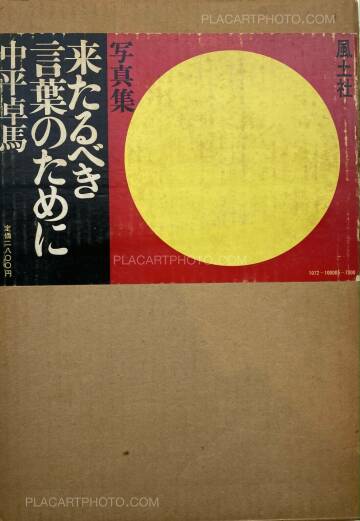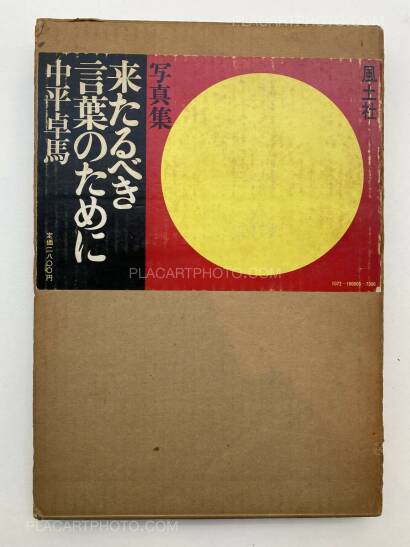For a language to come

Takuma Nakahira
For a language to come
Photographs: Takuma Nakahira
Text: Takuma Nakahira
Publisher: Fudo-sha
192 pages
Pictures: 103
Year: 1970
Comments: Hardcover with jacket and card slipcase, 300 x 212 mm. First edition, 1970. Gravure printing. Included in Martin Parr & Gerry Badger, The Photobook, vol. I, p.292-293 ; Ryuichi Kaneko & Ivan Vartanian, The Japanese Photobooks of the 1960's and 1970's, p.130-133. Very good condition other than a small tear to the spin of the dust jacket. Very scarce.
"Through his photographs and writings Takuma Nakahira was both the chief polemicist for the Provoke group and its political conscience. Along with Moriyama's Sashin yo Sayonara (Bye Bye Photography), his book Kitarubeki Kotoba no Tameni (For a language to come) marks the apogee of the Provoke period. It exhibits all the characteristics of the Provoke style - an unabashed revelling in "bad" photographic technique, the mannerisms of the New York School pushed to the edge of coherence. These qualities would tend to make the casual reader bracket it with Moriyama's masterpiece, yet a closer look at Nakahira's book reveals that Nakahira's sensibility is quite different. Althoug the more political of the two, Nakahira didt not photograph "political" subjects directly, but utilized a troubled lyricism to express his disaffection with the colonization of Japan by American consumerism. Whereas Moriyama is jumpy and frenetic in tone, Nakahira displays a brooding calm. For a language to come closes with several shots of the sea, and the book's narrative is punctured at intervals with marine images. Far from suggesting boundless space, this is a dark, bleak and menacing sea, with the consistency of soup, a metaphor for claustrophobia and a narrowing of horizons.
The other overwhelming metaphor in the book is fire, an apocalyptic, post-Hiroshima conflagration, often expressed indirectly in Nakahira's night pictures with swathes of burned-out lens flare. These "natural" metaphors - water and fire - remind us that this is essentially a "landscape" book, though a landscape of the mind. The two, however, are inextricably related (...). These are sad, beautiful pictures of half-light - and half-life. They are quintessential Provoke images, and stand for much postwar Japanese photography prior to the 1980s."
Martin Parr & Gerry Badger, The Photobook: A History, vol.I















more books by Takuma Nakahira
-
Okinawa, Amami, Tokara 1974-1978
by Takuma Nakahira
sold -
Overflow
by Takuma Nakahira
sold -
Degree Zero - Yokohama
by Takuma Nakahira
sold -
OKINAWA (LTD EDT)
by Takuma Nakahira
Euro 90 -
Aratanaru gyoushi / New Gaze
by Takuma Nakahira
sold
more books tagged »Takuma Nakahira« | >> see all
-
Provoke : Between Protest and Performance : Photography in Jap...
by Provoke group
sold -
Provoke : Between Protest and Performance : Photography in Jap...
by Provoke group
sold -
Provoke (Set of 3 vol. +1) 1968-1969
by Provoke group
price on request -
PROVOKE MAGAZINES (BACK IN STOCK)
by Collective
Euro 100 -
A Battlefield in the city
by Collective
sold -
Provoke 2 (First edition)
by Provoke group
price on request
more books tagged »japanese« | >> see all
-
Discology
by Katsumi Watanabe
sold -
TAKAHASHI KYOJI
by Kyoji Takahashi
sold -
Snowflakes Dog Man (Regular edition Signed)
by Hajime Kimura
sold -
Mr. Queen
by Akira Miyazaki
Euro 500 -
Sakebi: Urakaido no Seishun
by Various photographers
Euro 180 -
Record of Anger and Sadness
by Hiroshi Hamaya
Euro 400
more books tagged »provoke« | >> see all
-
Provoke (First edition)
by Provoke group
price on request -
Toshi-he / Towards the City (With rare shipping box)
by Yutaka Takanashi
price on request -
Photography 1965-74 (SPECIAL EDITION WITH PRINT)
by Yutaka Takanashi
sold -
Japan: a Photo Theater, Revised Edition (SIGNED)
by Daido Moriyama
sold -
The Japanese Box
by Collective
sold -
Farewell photography (SIGNED)
by Daido Moriyama
sold
more books tagged »seventies« | >> see all
-
Divined by dreams
by Mitsuya Okumura
sold -
BLOUSONS NOIRS
by Yan Morvan
sold -
Naked Festival / Hadaka Matsuri
by Tamotsu Yato
sold -
TEMPORADA FULGOR
by Collective
sold -
Les Fleurs du Mal - Réhabilitation par mon sexe
by Akira Suzuki
Euro 300 -
Andy Warhol (transcript of David Bailey's ATV documentary)
by David Bailey
Euro 90
more books tagged »japanese photobook« | >> see all
-
Site
by Daisuke Yokota
sold -
Kagerou
by Yusuke Takagi
sold -
Minamata Disease
by Fumiaki (Shisei) Kuwabara
sold -
APARTMENT (With Flyer and subscription form)
by Miyako Ishiuchi
sold -
Eigijin vol.1
by Collective
price on request -
Tokyo 2016-2017
by Michio Yamauchi
Euro 40
Books from the Virtual Bookshelf josefchladek.com






































;jpg)
;jpg)


 Facebook
Facebook Instagram
Instagram